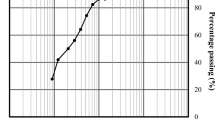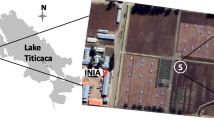Abstract
A comparison between three methods of determining cation exchange capacity values has been undertaken in order to evaluate the applicability of methylene blue for characterization of clayey soils. The Argiles vertes de Romainville, Marnes bleues d’Argenteuil (two very plastic, loamy soils from the Paris Basin which are known to experience shrink/swell) were tested in their natural and purified states, as well as samples of smectite, illite and interstratified illlite/smectite. The results from the methylene blue, turbidimetric and cobalt hexamine methods were similar, although the methylene blue gave slightly higher values. It is concluded that the differences seen are likely to be due simply to the degree of accuracy available with the various methods. Hence, the quicker and more convenient methylene blue method was realistic for use by geotechnical engineers. However, attention is drawn to the need to continue these tests to the “end point” which is some 24 h after the solution has stabilised.
Résumé
Une comparaison entre trois méthodes de détermination de la capacité d’échange de cations a été réalisée afin d’évaluer la méthode d’adsorption de bleu de méthylène pour les sols argileux. Les Argiles vertes de Romainville, les Marnes bleues d’Argenteuil (deux formations argileuses plastiques du bassin de Paris réputées pour leur aptitude au retrait-gonflement) ont été testées en état naturel et purifié, ainsi que des échantillons de smectite, d’illite et d’interstratifié illite/smectite. Les résultats obtenus à partir de la méthode au bleu de méthylène, la méthode turbidimétrique et la méthode au cobalt hexamine sont semblables, bien que la méthode au bleu de méthylène donne des valeurs légèrement plus fortes. On conclut que les différences observées sont probablement dues au niveau de précision attaché à chaque méthode. De ce fait, la méthode d’adsorption de bleu de méthylène, plus rapide et pratique, apparaît correcte pour les caractérisations géotechniques. Cependant, l’attention est attirée sur la nécessité de poursuivre ces tests à terme, ce qui correspond à une durée de 24 h après stabilisation de la solution.











Similar content being viewed by others
References
AFNOR (1990) NF P18-595. Granulats—Valeur de bleu de méthylène—Méthode turbidimétrique
AFNOR (1993) Sols. Reconnaissance et Essais – Détermination des limites d’Atterberg—Limite de liquidité à la coupelle—Limite de plasticité au rouleau. Association Française de Normalisation
AFNOR (1999) NF X 31-130. Qualité des sols. Méthodes chimiques. Détermination de la capacité d’échange cationique (CEC) et des cations
AFNOR (2003) NF P 94-048. Reconnaissance et Essais—Détermination de la teneur en carbonate—Méthode du calcimètre
Al-Rawas AA (1998) The factors controlling the expansive nature of the soils and rocks of northern Oman. Eng Geol 53:327–350
Brindley GW, Brown G (1980) X-ray diffraction procedures for clay mineral identification. In: Crystal structures of clay minerals and their X-ray identification. Mineralogical Society, London
Caillère S, Henin S, Rautureau M (1982) Minéralogie des argiles Tomes I & II. Masson, Paris
Carter DL, Heilman MD, Gonzalez CL (1965) Ethylene glycol monoethyl ether for determining surface area of silicate minerals. Soil Sci 100:356–360
Chiappone A, Marello S, Scavia C, Setti M (2004) Clay mineral characterization through the methylene blue test: comparison with other experimental techniques and applications of the method. Can Geotech J 41:1168–1178
Christidis GE (1998) Physical and chemical properties of some bentonite deposits of Kimolos. Island, Greece. Appl Clay Sci 13:79–98
Clément C (1988) Étude de coulis hydrauliques pour la rétention de cations polluants : Pb, Cd, Hg, Sr, Cs, thesis, Ecole Nationale Supérieure des Mines de Paris
Dasog GS, Acton DF, Mermut AR, DeJong E (1988) Shrink-swell potential and cracking in clay oils of Saskatchewan. Can J Soil Sci 68:251–260
Dixon JB, Weed SB (1977) Minerals in soil environments. Eds, Soil Sci Soc Am. Madison, 948 p
Drits VA, Tchoubar C (1990) X ray diffraction by disordered lamellar structures: theory and application to micro-divided silicates and carbons. Springer, New-York
Farrar DM, Coleman JD (1967) The correlation of surface area with other properties of nineteen British clay soils. J Soil Sci 18:118–124
Glaser R, Mering J (1968) Homogeneous hydration domains of the smectites. C R Hebd Séances Acad Sci 267:436–466
Green-Keely R (1957) The montmorillonite minerals. In: Mackenzie RC (ed) The differential thermal investigation of clays, Mineralogical Society, London
Laribi S, Fleureau JM, Grossiord JL, Ariguib N (2006) Effect of pH on the rheological behavior of pure and interstratified smectite clays. Clay Miner 54:29–37
Laribi S, Jouffrey B, Fleureau JM (2005) Observation of freeze-dried smectite plan views of nano-layers. Appl Phys Lett 86:231915
Laribi S, Cojean R, Audiguier M, Grambin C, Geremew Z (2007) Essai d’adsorption de bleu de méthylène : influence de paramètres du protocole expérimental sur la valeur au bleu en fonction de la minéralogie des argiles. Revue Française de Géotechnique 120–121:85–93
Low PF (1980) The swelling of clay: II. Montmorillonites. Soil Sci Soc Am J 44:667–676
Reynolds RC (1980) Interstratified clay minerals, in Crystal structure of clay minerals and their X-ray identification. In: Brindley GW, Brown G (eds) Mineralogical Society, London, pp 249–303
Moore DM, Reynolds RC (1997) X-ray diffraction and the identification and analysis of clay minerals, 2nd edn. Oxford University Press, Oxford
Tanaka H, Locat J (1999) A microstructural investigation of Osaka Bay clay: the impact of microfossils on its mechanical behaviour. Can Geotech J 36:493–508
Van Olphen H (1977) Introduction to clay colloid chemistry, 2nd edn. Wiley, New York
Weir AH, Greene-kelly R (1962) Beidellite. Am Miner 47:137–146
Williams AB, Donaldson GW (1980) Building on expansive soils in South Africa: 1973–1980. In: Proceedings of 4th international conference on expansive soils
Yilmaz I (2006) Indirect estimation of the swelling percent and a new classification of soils depending on liquid limit and cation exchange capacity. Eng Geol 85:295–301
Acknowledgments
This work was carried out within the framework of the research project “Shrink/swell hazard and damage” supported by Fondation MAIF.
Author information
Authors and Affiliations
Corresponding author
Rights and permissions
About this article
Cite this article
Laribi, S., Audiguier, M. & Cojean, R. Assessing shrink/swell properties of two argillaceous soils from the Paris Basin: a comparison of cation exchange determination methods. Bull Eng Geol Environ 67, 415–424 (2008). https://doi.org/10.1007/s10064-008-0149-y
Received:
Accepted:
Published:
Issue Date:
DOI: https://doi.org/10.1007/s10064-008-0149-y
Keywords
- Argiles vertes de Romainville
- Marnes bleues d’Argenteuil
- Shrink/swell
- Cation exchange capacity
- Methylene blue test




